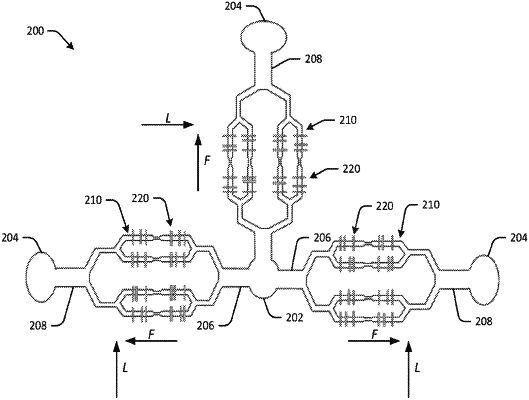| CPC B01L 3/502715 (2013.01) [B01L 2300/0645 (2013.01); B01L 2300/0816 (2013.01); B01L 2300/0864 (2013.01); B01L 2300/0883 (2013.01)] | 20 Claims |

|
1. A microfluidic device for cell mechanophenotyping, the microfluidic device comprising:
an inlet; and
a plurality of branches, wherein each branch comprises:
an outlet;
a first channel in fluid communication with the inlet and the outlet, the first channel comprising:
a first upstream zone having a first cross-sectional area in a lateral direction perpendicular to a direction of fluid flow through the first channel;
a first downstream zone having a second cross-sectional area in the lateral direction; and
a first constriction zone positioned between the first upstream zone and the first downstream zone and having a third cross-sectional area in the lateral direction, the third cross-sectional area being less than each of the first cross-sectional area and the second cross-sectional area;
a second channel arranged in parallel with the first channel and in fluid communication with the inlet and the outlet, the second channel comprising:
a second upstream zone having a fourth cross-sectional area in the lateral direction;
a second downstream zone having a fifth cross-sectional area in the lateral direction; and
a second constriction zone positioned between the second upstream zone and the second downstream zone and having a sixth cross-sectional area in the lateral direction, the sixth cross-sectional area being less than each of the fourth cross-sectional area and the fifth cross-sectional area;
a first sensor pair positioned along the first channel, the first sensor pair comprising:
a first entry sensor positioned along the first upstream zone and configured to detect a first cell flowing through the first upstream zone; and
a first exit sensor positioned along the first downstream zone and configured to detect the first cell flowing through the first downstream zone; and
a second sensor pair positioned along the second channel, the second sensor pair comprising:
a second entry sensor positioned along the second upstream zone and configured to detect a second cell flowing through the second upstream zone; and
a second exit sensor positioned along the second downstream zone and configured to detect the second cell flowing through the second downstream zone;
wherein the first entry sensor comprises a first plurality of electrodes having a first electrode configuration, wherein the first exit sensor comprises a second plurality of electrodes having the first electrode configuration, wherein the second entry sensor comprises a third plurality of electrodes having a second electrode configuration different from the first electrode configuration, and wherein the second exit sensor comprises a fourth plurality of electrodes having the second electrode configuration;
wherein having the second electrode configuration different from the first electrode configuration enables assignment of a unique identifier to each of the first channel and the second channel.
|